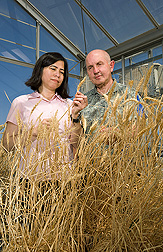This page has been archived and is being provided for reference purposes only. The page is no longer being updated, and therefore, links on the page may be invalid.
|
Read the magazine story to find out more. |
|
|
|
|
Exposing Wheat's Genetic Secrets
By Marcia WoodSeptember 21, 2007
Every day, bakers from coast to coast make fresh, fragrant loaves of bread for us to enjoy. Wheat flour, of course, is a star ingredient in many of the most popular breads.
The work of tomorrow's millers and bakers might be made much easier by studies under way at the Agricultural Research Service (ARS) Western Regional Research Center in Albany, Calif. There, scientists like plant geneticists Olin D. Anderson and Yong Q. Gu are tackling some of the mysteries surrounding wheat's genetic makeup.
Their discoveries may one day help millers provide bakers with flour that is both consistent and predictable—two highly prized traits. These superior flours would consistently make doughs that have the optimal balance of strength and elasticity. That could, according to Gu, take away the need to blend various different flours—a costly, sometimes frustrating task for today's millers.
Gu, Anderson and others in the Genomics and Gene Discovery Research Unit at Albany are exploring wheat's remarkably complicated, mostly undeciphered genetic makeup, or genome. Wheat is a complex union of three ancestral grass genomes that together make the wheat genome huge—about 10 times the size of the human genome, according to Anderson.
The Albany researchers are hunting for naturally occurring differences in the order of appearance, or sequence, of the infinitesimally small units—called "nucleotides—that make up genes. The differences that they're interested in are known as "single nucleotide polymorphisms," or "SNPs" (pronounced "snips") for short.
Though tiny, SNPs are not trivial. In wheat plants, a SNP might mean the difference between having high amounts of a protein important in breadmaking—or very low amounts of it. Single-nucleotide variations could affect genes for many other key wheat-plant traits, such as resistance to insects or diseases.
Read more about the research in the September 2007 issue of Agricultural Research magazine.
ARS is the U.S. Department of Agriculture's chief scientific research agency.


